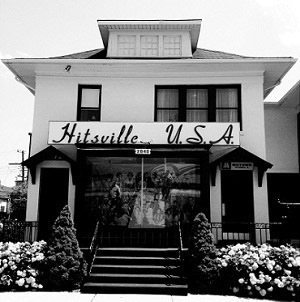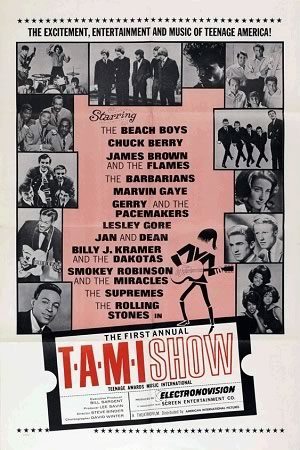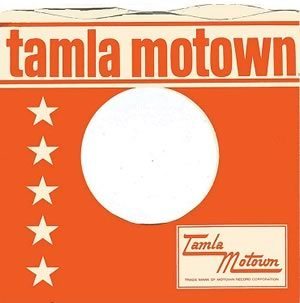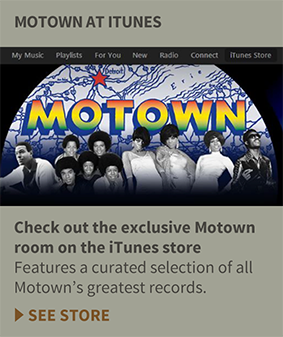Berry Gordy Jr. launched his record company in January 1959 with two solo singers, Marv Johnson and Eddie Holland, and soon gained further experience from the success of another vocalist, Barrett Strong.
Yet it is the groups of Motown who have largely defined the sound and soul sent around the world from “Hitsville U.S.A.” at 2648 West Grand Boulevard, Detroit: The Miracles, The Marvelettes, Martha & The Vandellas, The Supremes, Jr. Walker & The All Stars, The Isley Brothers, The Temptations, and the Four Tops. And later, based in California, the likes of the Jackson 5 and the Commodores.
 The Miracles have pride of place, of course. On their initial success, Gordy built his business. The son of a plasterer, he did that in America’s heartland, away from the traditional music capitals. And the iconic map of Detroit printed in the centre of so many Motown singles and albums became more than a lesson in geography. Calling out around the world, the music and artists associated with the company empowered a generation, and influenced the sound of popular music ever since. The foundations were evident in winter ’59, when Gordy proudly collected boxes of his company’s first 45 from a snowbound pressing plant in Owosso, Michigan. He was accompanied by the leader of his most precious asset, The Miracles. Smokey Robinson had urged Berry to set up on his own, rather than licensing recordings to other labels: “Why work for the Man? You be the Man.”
The Miracles have pride of place, of course. On their initial success, Gordy built his business. The son of a plasterer, he did that in America’s heartland, away from the traditional music capitals. And the iconic map of Detroit printed in the centre of so many Motown singles and albums became more than a lesson in geography. Calling out around the world, the music and artists associated with the company empowered a generation, and influenced the sound of popular music ever since. The foundations were evident in winter ’59, when Gordy proudly collected boxes of his company’s first 45 from a snowbound pressing plant in Owosso, Michigan. He was accompanied by the leader of his most precious asset, The Miracles. Smokey Robinson had urged Berry to set up on his own, rather than licensing recordings to other labels: “Why work for the Man? You be the Man.”
A few years earlier, as the operator of an eclectic record store, Gordy learned the hard way that jazz might nourish the soul, but didn’t pay the bills. Then, as a budding songwriter, he placed hits into the hands of a mass-appeal Motor City son, Jackie Wilson, who had gone solo from Billy Ward’s Dominoes. This earned Berry the respect of his family, and an $800 loan which led him to open the doors of a former photographer’s house as Hitsville U.S.A.
When aspiring youngsters approached the fledgling record company, “they were not writers, they were not producers, they were not anything,” Gordy once explained to a British journalist, “they were just smart kids off the street, and they could be channelled and directed.” They were just like him, he added. “All they needed was a chance to express their ideas.”
 Now those ideas are the DNA of popular music. Diana Ross’ eternal ache in “Where Did Our Love Go,” the honey-and-sandpaper of The Temptations’ “My Girl,” and the sanctified call-and-response of the Four Tops’ “I Can’t Help Myself” are subliminally programmed into half the hit records you’ve ever heard, or seen on The X Factor or American Idol. Just as – from the basement recording studio at Hitsville – the lockstep drums of Benny Benjamin and the heartbeat bass of James Jamerson are the unerring metronomes of, well, most of the other half.
Now those ideas are the DNA of popular music. Diana Ross’ eternal ache in “Where Did Our Love Go,” the honey-and-sandpaper of The Temptations’ “My Girl,” and the sanctified call-and-response of the Four Tops’ “I Can’t Help Myself” are subliminally programmed into half the hit records you’ve ever heard, or seen on The X Factor or American Idol. Just as – from the basement recording studio at Hitsville – the lockstep drums of Benny Benjamin and the heartbeat bass of James Jamerson are the unerring metronomes of, well, most of the other half.
Can there anywhere be a jukebox, digital or physical, that does not offer “Dancing In The Street,” “Reach Out I’ll Be There,” or “The Tracks Of My Tears”? Can there be DJs anywhere who haven’t shouted out with “Dancing In The Street,” “Get Ready” or “You Can’t Hurry Love?”
History has registered the tale of how Gordy and his extended family machine-tooled a litany of record labels (Tamla, Motown, Gordy, Soul and more) into the most awesome hit factory of his age. How he disciplined and then magnified the raw musical talent of Detroit. And found ways to shape so many young people into global stars.
If in doubt, consider the success of Motown the Musical on Broadway. Moreover, now the show is a smash in London, drawing crowds in the country where the legend is known as Tamla Motown. Then there’s Las Vegas, where Human Nature, a quartet of clean-cut white boys from Australia – yes, that’s Australia – attracted audiences year after year with their act built around the Motown songbook. Or Germany, where a jazz/pop choir called the Young Voices of Brandenburg harmonized on “Reach Out I’ll Be There,” “I Heard It Through The Grapevine” and more.
Even Gordy’s backroom boys, for heaven’s sake, have their place in the sun. Nobody thinks that Holland/Dozier/Holland is a firm of lawyers, and the story of Motown’s awe-inspiring house band, the Funk Brothers, has been celebrated on celluloid and screened in cinemas worldwide: Standing In The Shadows Of Motown. The bass-playing son of the Funks’ late James Jamerson even took to the road with a show and set list comprising Motown classics, before his premature death in 2016.
As a songwriter in the days before Motown, Gordy knew that success meant having more than one performer record his material. That validated his composing talent, and put more money in the bank. As Motown and its music publishing wing, Jobete, grew, Gordy put his copyrights to work. Determined to control the destiny of his young business with as little outside help as possible, he developed an in-house team of writers and producers who worked and competed passionately. He encouraged them to experiment with singers and songs to find the best match, and to keep the publishing income in-house.
You’ll find “You’ve Really Got A Hold On Me” as originally recorded by The Miracles, but also by The Supremes and the Jackson 5. Sure, “Shop Around” is one of the Miracles’ signature tunes, but it’s also been cut by the Spinners and Mary Wells. “Forever” is a Marvelettes B-side also put on tape by Martha & the Vandellas, and Marvin Gaye. “Who’s Lovin’ You” is the flipside of the Miracles’ first No. 1 on the R&B charts – and, nine years later, of the Jackson 5’s debut Motown single, “I Want You Back.”
 Sometimes, the same Motown backing track underpins two entirely different songs: The Isley Brothers’ recording of “Smile” has exactly that in common with Jimmy Ruffin’s 1966 classic “What Becomes Of The Brokenhearted” – although, admittedly, the Isleys’ mirror-image wasn’t released until 2004.
Sometimes, the same Motown backing track underpins two entirely different songs: The Isley Brothers’ recording of “Smile” has exactly that in common with Jimmy Ruffin’s 1966 classic “What Becomes Of The Brokenhearted” – although, admittedly, the Isleys’ mirror-image wasn’t released until 2004.
As Motown developed from three-track to eight-track recording in January 1965, the mixing and matching became easier. And as the company began to assemble albums to replicate the torrid success rate of its singles output, the depth of its songwriting talent became even more essential.
The epicentre of this activity was the Friday morning A&R meeting, held at the Motown headquarters on West Grand. Gordy’s team – including Smokey Robinson, Brian Holland and Lamont Dozier, Mickey Stevenson, Johnny Bristol, Norman Whitfield, Ivy Jo Hunter and Hank Cosby – would present their week’s work on acetates, hoping to gain the approval of the room.
Some producers would test their mettle on songs which had already been hits, changing the groove, the tempo, the inflections. Anything to catch an ear, land a slot on an album, take another step closer to the A-Team. Others wanted the opportunity to work with a particular artist for the first time, or with an act new to the company, to strike up a hitmaking rapport.
The A-Team, Holland/Dozier/Holland, got first crack at The Isleys when the brothers landed at Motown in 1965, but writers Thomas Kemp and George Gordy (yes, the boss’ brother) earned the right to the trio’s second, rocking single release. Likewise, the Isleys’ third Motown R&B hit came from the pens of new composers Leon Ware and Stephen Bowden, together with Ivy Jo Hunter.
There is another reason why Berry Gordy was able to consistently extract innovation and excellence from his artists and producers: a studio band on tap and on top, 24/7. The Funk Brothers were a cadre of in-house musicians whose skill, instincts and adaptability were the precision tools of the Motown production line: James Jamerson on bass; Benny Benjamin on drums; Uriel Jones and “Pistol” Allen, also drummers; Earl Van Dyke and Johnny Griffith on keyboards; Robert White, Joe Messina and Eddie Willis on guitars; Jack Ashford, vibes and percussion; James Gittins, vibes; and Eddie “Bongo” Brown (congas/bongos), to name a few.
They came to know instinctively what each producer wanted and needed, as did arrangers Paul Riser, David Van dePitte, Wade Marcus and Willie Shorter. Without the occupants of the “Snakepit,” as the studio was dubbed, Motown simply could not have sustained the quality and quantity of its output. The hits couldn’t have kept on coming.
 Of course, Berry was shrewd enough to seek additional insurance for his company’s prime assets. From the beginning, he lectured the Motown roster on the virtues of versatility, schooling them to handle the work of such Tin Pan Alley magicians as Cole Porter, Rodgers & Hart, and George Gershwin. He made sure these American classics were part of his stars’ stage repertoire, to guarantee their appeal to “adult” audiences at nightclubs in New York, Las Vegas, or London.
Of course, Berry was shrewd enough to seek additional insurance for his company’s prime assets. From the beginning, he lectured the Motown roster on the virtues of versatility, schooling them to handle the work of such Tin Pan Alley magicians as Cole Porter, Rodgers & Hart, and George Gershwin. He made sure these American classics were part of his stars’ stage repertoire, to guarantee their appeal to “adult” audiences at nightclubs in New York, Las Vegas, or London.
It’s no accident that Motown’s album catalogue includes The Supremes’ Sing Rodgers & Hart, the Four Tops’ On Broadway and The Temptations’ In A Mellow Mood. Then again, it was obviously difficult to persuade some: Jr. Walker & The All Stars were never booked at the Copa.
All this aside, we know that Motown was also Black America’s economic beacon, for many years the largest and most successful African-American enterprise. Today, capitalist journals like Fortune and Business Week illuminate the acumen and drive of Jay-Z, Russell Simmons and Puff Daddy. Who do you think wrote the book?
Berry Gordy applied the two centrifugal forces of large families – love and competition – to his company and its art. A father figure for many of the groups and soloists who signed on at Hitsville, he encouraged those backroomers, in particular, to vie with each other, trusting that it would bring out their full potential. If Smokey’s last song for The Temptations was a smash, he got to produce their next. If it wasn’t, Norman Whitfield got the shot. Gordy liked to say that competition breeds champions.
As for family: a couple of The Marvelettes married a Miracle and a Contour, respectively; a Gordy daughter married a Jackson; a Motown A&R chief married a singer. And, as if he were kin, the Funk Brothers helped to turn 12-year-old Stevie Wonder’s formidable musical passion into monumental talent.
 It was no coincidence that a company song, penned by Smokey Robinson, declared, We’re all for one/And one for all, nor that Berry Gordy’s enterprise took to calling itself “The Sound of Young America.”
It was no coincidence that a company song, penned by Smokey Robinson, declared, We’re all for one/And one for all, nor that Berry Gordy’s enterprise took to calling itself “The Sound of Young America.”
During the 1960s, Motown was the sound of a torch being passed to a new generation, which was under the influence of such 1950s groups as Billy Ward’s Dominoes and Nolan Strong’s Diablos, but looking to express itself with its own voice. That voice was heard in “Heat Wave” and “Going To A Go-Go” and “Ain’t Too Proud To Beg” and “Standing In The Shadows Of Love” and “This Old Heart Of Mine (Is Weak For You)” and many more.
In time, of course, all children leave home, all roads lead away. “You know that they’re going to be independent [one day],” Berry Gordy admitted. “When that day comes, even though you expect it and work for it, it’s devastating.”
Fifty years on, Motown’s offspring have children and grandchildren, literally and figuratively. The Detroit bloodline pulses through modern music, just as the songs have become integrated into America’s cultural heritage, resonating in the 21st century. Teenagers take to the TV screen to sing “My Girl” or “Who’s Lovin’ You” on American Idol, then ring up the views on YouTube.
On the stage of a London concert hall in January 2004 stood Jack Ashford, one of the Funk Brothers, in front of an exuberant, sellout crowd of baby boomers and their children who had come to hear Detroit’s heartbeat. “We recorded music that brought the world together,” he declared, quite accurately. Outside, there was snow on the ground, just as there had been 45 years earlier on the icebound roads of Michigan, when Berry Gordy Jr. and his young team began Motown’s journey into history.
Credit: http://www.udiscovermusic.com/features/motown-the-groups





